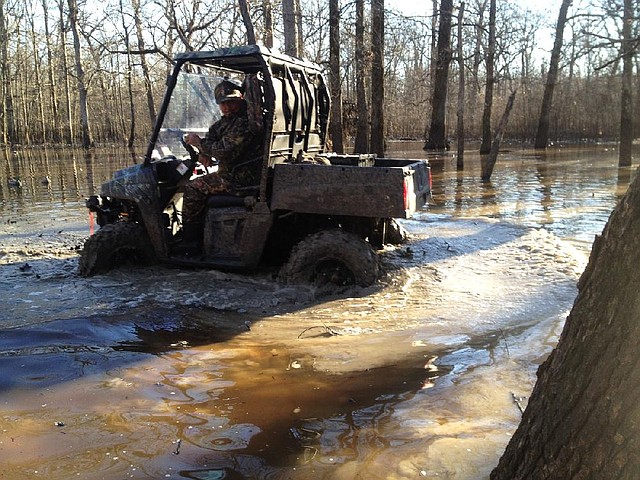A blessed plenty
Humnoke duck hunt steeped in history
Sunday, December 30, 2012
HUMNOKE — Just being here seeped history, especially in such esteemed company.
Picture it.
Flooded hardwood bottoms along the Big Ditch before dawn. The air was still and calm, spiked with the sharp bite of winter. Mallards were all around us, calling in the darkness. Bruce Sharp fired them up even more by belting out an owl hoot. It’s an old turkey hunter’s trick to make a tom turkey gobble on the roost, but it makes mallard hens talk, too.
Sharp, 79, has been hunting this particular patch of woods for 70 years. His father was part of the group that bought the place for dunk hunting in the 1930s. They agreed they would never sell any of their shares to anyone outside the group, so when someone opted out, he had to sell to a member. Otherwise, they passed their shares on to their heirs.
So here it is, nearly 160 acres of pristine bottom land hardwoods that looks as it did in the 1930s and 1940s, an era that some say was the golden age of Arkansas duck hunting. Nash Buckingham hunted near here and made the area famous with his writings, as did Ernest Hemingway. It was wasteland back then, but duck hunting has made it some of the most desirable land in the state from a recreational standpoint.
Sharp is well aware of the history and heritage, but he appreciates these woods most of all because it is such a big part of his life. He remembers the early days, when ducks descended on these woods by the tens of thousands.There were a lot fewer hunters then and a lot less competition for birds. He said it was common to call down flocks numbering in the hundreds. He remembers the lean times, too, in the 1970s and 1980s, but still he kept coming.
“There were days you could come down here and kill maybe one duck, if that,” Sharp said. “I didn’t mind because I loved being here so much.”
Duck numbers have rebounded since then, and we are experiencing what might be the greatest duck migration of our generation. Because of Sharp and other like minded stewards who kept the woods intact instead of draining them for agriculture, the birds still have a place to come. And come they do, to the extent that Sharp says the hunting is as good as ever, given the competition.
Hunting is just part of the adventure. Getting here is the other part.
I arrived at about 5:20 a.m. with John Burnett of Little Rock. Sharp arrived shortly after, along with Steve Brooks of Little Rock. They had a Polaris Ranger UTV, which can navigate just about anything. I rode on the back of Burnett’s Suzuki King Quad. After traveling a mile or so down a levee bordering the Big Ditch, we turned into the water. It didn’t quite come to the top of the Suzuki’s tires, which is a great dabbling depth for ducks. However, we did not anticipate the deep hole that submerged the headlights. Burnett dogged onward, and thankfully it was not very long.
Within minutes we arrived at two hulking old blinds. They had sufficient space beneath the bottom floors to park the vehicles. Stairs led to the shooting deck, which contained platforms for the callers. Burnett and I opted to hunt from the water, so we stood near each other beside a couple of big oak trees while Sharp and Brooks manned the blinds. We all had commanding views of the hole, which contained two lines of decoys attached to a jerk string, as well as two spinning wing decoys.
Ducks sounded off from every direction, and as the sky lightened the air filled with the whistling sound of wing beats mixed with the feeding cackles of the hens and the nasal whines of drakes. A large contingent of wood ducks on the water sounded like a gaggle of young girls at a Justin Bieber concert.
Ducks came into the hole and flew away while we waited, but a small flock of mallards arrived just after shooting time. I got one drake and Burnett got the other. Wood ducks streaked through the woods, too. They came and went too fast to shoot, but Brooks managed to get a very handsome drake woodie.
Being a Saturday, of course, there were a lot of hunters about, so the ducks were harried and wary. They worked our hole very well at first, but just as a group would commit to landing, a barrage erupted somewhere close and the ducks flared and fled. It happened several times as the vanguard of the flight began its descent, with the lead ducks hovering and their heads bent over like lamp handles. As the morning progressed, they became increasingly “hole shy.”
“There were a couple of times when single drakes came over, and when I called to them they jerked their heads almost all the way around,” Brooks said. “You don’t see that very often.”
Then, a big group settled into a thicket about 100 yards from us. That’s always the death knell for a hunting hole because no matter how good your spread looks, it can’t compete with real ducks.Even so, small groups came in here and there, allowing us all to get a limit of mallards. We shot mostly drakes and finished by about 8 a.m.
“We’ve had us a’ plenty,” Sharp said. “A blessed plenty.”
Sports, Pages 25 on 12/30/2012
